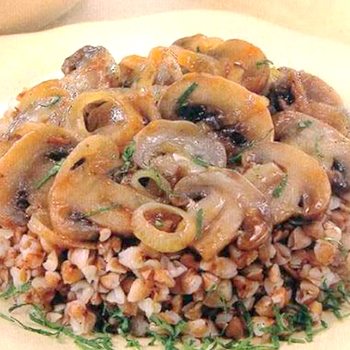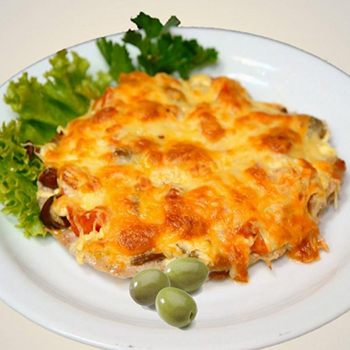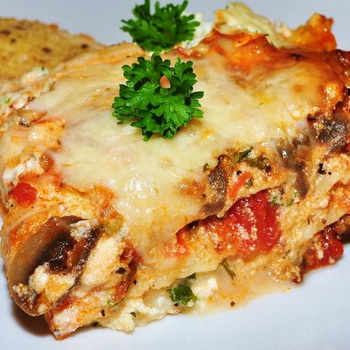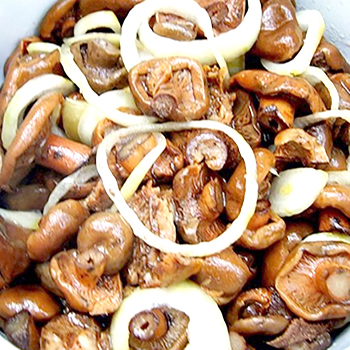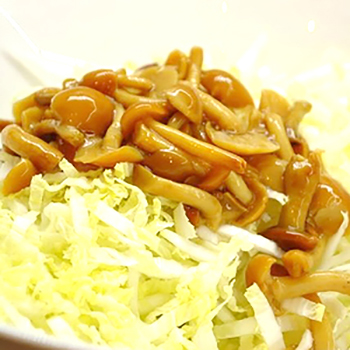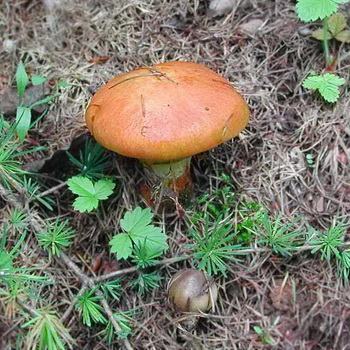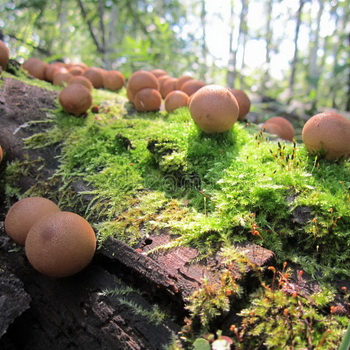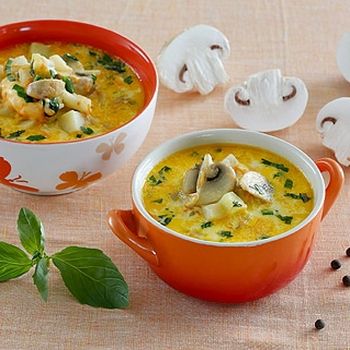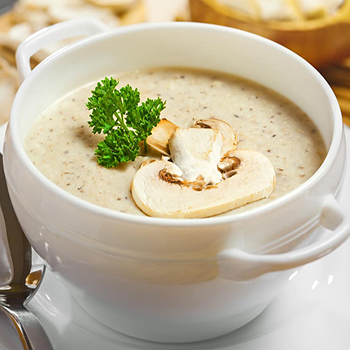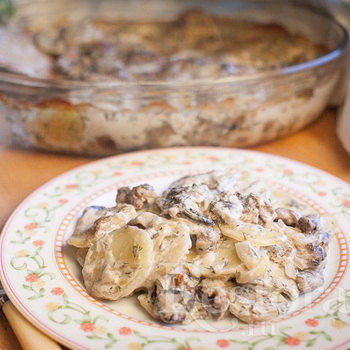Edible russula mushrooms: photo and description of the species and varieties of russula (greenish, food, pink)
 Edible russula are one of the most common mushrooms in our latitudes. These gifts of the forest with multi-colored caps are not delicacies, although their taste is in no way inferior to other mushrooms. In cooking, all varieties of edible russula are used in boiled, fried, salted and pickled forms. These mushrooms are also used as a filling for pies. Many types of russula are suitable for drying.
Edible russula are one of the most common mushrooms in our latitudes. These gifts of the forest with multi-colored caps are not delicacies, although their taste is in no way inferior to other mushrooms. In cooking, all varieties of edible russula are used in boiled, fried, salted and pickled forms. These mushrooms are also used as a filling for pies. Many types of russula are suitable for drying.
On this page you will find out what edible russula look like (greenish, pink, food, fade, bilious and others), where and when these mushrooms grow, how they are used in cooking, and which edible russula are most popular. You will also receive information about conditionally edible russules and their distribution halo.
Edible russula greenish and its photo
Category: edible.
Cap of a greenish russula (Russula virescens) (diameter 5-16 cm): green, but can be yellowish or bluish. In young mushrooms it is hemisphere-shaped, in older mushrooms it is spread. Fleshy, often cracked. The skin is very thick, it is difficult to separate from the pulp.
Leg (height 4-12 cm): usually white.


If you look closely at the photo of the greenish russula, you can see small scales at the very base of the leg.
Plates: frequent, white or light cream color.
Pulp: dense and whitish, slightly pungent in taste.
Doubles: greenish representatives pale toadstool (Amanita phalloides), differ from russula in that they have a ring on the leg and a Volvo.
This edible russula grows from mid-July to early October in temperate countries.


Where can I find: in deciduous and mixed forests, most often in the vicinity of oaks and birches.
Eating: one of the most delicious russula, which can be eaten after 15 minutes of boiling, pickled, salted or dried.
Application in traditional medicine: does not apply.
Other names: russula scaly.
What are edible russula: food
Category: edible.


Hat for food russula (Russula vesca) (diameter 4-12 cm): matte, pink-red, brick or red-brown. In young mushrooms, it is hemispherical, becoming almost flat over time. Slightly sticky to the touch in wet weather. The edges are curved towards the inner side, sometimes wavy and ribbed. The skin does not completely cover the flesh, exposing the plates at the edges, it is easily removed only from the edges.
Leg (height 3-7 cm): white, yellow or pinkish-rusty, very short, cylindrical in shape. Dense in young mushrooms, hollow in older ones.
The plates of this species of russula mushrooms are very frequent, white or yellowish, sometimes with rusty spots.


Pay attention to the photo of food russula: its flesh is fleshy and dense, white, brittle. No pronounced odor.
Doubles: russula relatives, but only the food skin does not cover the plates.
When it grows: from mid-July to late September in Europe.
Where can I find: in forests of all types, especially in the vicinity of birches and oaks.
Eating: delicious mushroom. It is used in any form, provided that it is boiled for 15 minutes.
Application in traditional medicine: does not apply.
Other names: russula edible.
What pink edible russules look like (photo of mushrooms)
Category: conditionally edible.


Pink russula hat (Russula rosea) (diameter 5-11 cm): pink, sometimes fading to almost white. Fleshy, slightly arched or almost completely prostrate, with ribbed edges.
Leg (height 3-6 cm): white or pinkish, thickened at the base.


As you can see in the photo of the pink russula, its plates adhere tightly to the leg, have a cream or light brown color.
Pulp: white or slightly pinkish, bitter in taste.
Doubles: absent.
When it grows: from mid-August to early October.


Where can I find: on sandy soils of pine forests.
Eating: only in salty form.
Application in traditional medicine: does not apply.
Edible russula mushrooms short-legged and their photos
Category: edible.


Cap of the short-legged russula (Russula brevipes) (diameter 7-22 cm): dull, white, sometimes cracked and with yellowish spots. In adult mushrooms, they are flat or depressed.
Leg (height 2-6 cm): as the name suggests, it is rather short and cylindrical in shape.


In the photo of the edible russula mushroom of this variety, it can be seen that the leg is most often white or brownish.
Doubles: absent.
When it grows: from the beginning of August to the end of September.


Where can I find: in deciduous forests. Due to the very short stem, only the cap can be seen.
Eating: the mushroom is delicious fried and salted.
Application in traditional medicine: does not apply.
Edible ocher russula
Category: edible.
Cap of ocher russula (Russula ochroleuca) (diameter 6-11 cm): yellow or ocher, slightly convex in shape, often slightly depressed in the center and with edges curved towards the inner side. Smooth to the touch, slightly sticky in wet weather, and in hot dry weather. The skin is easily removed only at the edges.
Leg (height 4-8 cm): white or yellowish, very dense and dry, cylindrical in shape.


Pay attention to the photo of an edible russula of this type: very frequent, thin and narrow plates are painted in cream, yellow or white.
Pulp: dense and firm, white in color, which darkens slightly at the cut. It does not have a pronounced odor, it tastes pungent.
Doubles: absent.
When it grows: from mid-August to early October in southern Europe.
Where can I find: in deciduous and coniferous forests, often adjacent to spruces, birches and oaks. Can burrow into moss or forest floor.
Eating: after 15 minutes of boiling and salted.
Application in traditional medicine: does not apply.
Other names: russula pale ocher, russula pale yellow, russula ocher yellow.
Blue-yellow russula mushrooms: photo and description (Russula cyanoxantha)
Category: edible.


Hat (diameter 5-16 cm): magenta, purple or lilac, various shades of blue, and green. In young mushrooms, it is hemispherical, with time it becomes more open or even slightly depressed. The edges are usually curved towards the inside and often cracked. The skin, which may be wrinkled, is easily removed from only two thirds, and in the center only with pieces of pulp. It is usually dry to the touch, but becomes slightly sticky in wet weather.
Leg (height 5-13 cm): white or grayish, sometimes with a faint lilac tint. Slightly wrinkled, cylindrical in shape. In young mushrooms it is dense, in old ones it is hollow.


Plates: frequent and wide, usually growing tightly to the stem. Hard and unbreakable, white or cream colored.
Pulp: in young mushrooms it is dense, in old mushrooms it is fragile, brittle and cotton-like, may turn slightly gray at the cut. Does not have a pronounced odor.


According to the photo and description, blue-yellow russula mushrooms are very similar to all other types of russula with a similar cap color. However, blue-yellow russules have much more brittle plates.
Application in traditional medicine: does not apply.
When it grows: from late June to early September, often found in the Urals. It is considered one of the earliest representatives of russula.
Other names: russula blue-green, multi-colored russula.


Where can I find: in forests of all types, but most often in mixed ones. Prefers the neighborhood of birches, oaks, aspens and spruces.
Eating: a very tasty mushroom, boiled for 10-15 minutes, pickled and salted.
Description of whole russula mushrooms
 Category: edible.
Category: edible.
Plates: dirty yellow or grayish, fleshy, noticeably behind the stem.
Pulp: white and brittle, young mushrooms have a sweetish taste, old mushrooms have a pungent taste.
Whole russula hat (Russula integra) (diameter 5-13 cm): shiny, usually reddish-brown, can be with a dark yellow, olive or purple tint. Dense, has the shape of a hemisphere, eventually becomes almost flat with a slight depression in the center. Wavy edges often have cracks and may bend towards the inside. The skin, slightly sticky to the touch, easily comes off the pulp.
Leg (height 5-6 cm): usually white or pinkish, sometimes with yellow spots or small wrinkles. Strong, cylindrical.
Application in traditional medicine: does not apply.
Other names: russula is wonderful.
According to the description, whole russula mushrooms can be confused with green-red ones (Russula alutacea). However, green-red russules are much larger and have creamy plates that are well adhered to the stem.
When it grows: from mid-July to early September in temperate countries of the Eurasian continent.
Where can I find: on calcareous soils of coniferous or mixed forests.
Eating: fresh or salted.
Type of russula blackening and its photo
Category: conditionally edible.


Hat of the blackening russula (Russula nigricans) (diameter 5-20 cm): usually brown or brown. In young mushrooms it is convex and with edges curved towards the inner side, in mature mushrooms it is spread. The edges are lighter than the center. Sticky to the touch, therefore often with small twigs or leaves.
Leg (height 3-9 cm): very hard, cylindrical. In young mushrooms, it is almost white, with time it becomes brown or blackens.
Plates: sparse and thick, growing tightly to the stem. Initially white, gradually turning black.
Pulp: very dense and light, quickly changes color to red, and then almost black. Bitter taste.


The above type of russula with a photo and description is very similar to a bile russula. Both of these varieties of russula are classified as conditionally edible, since they require prolonged heat treatment.


Doubles: black russula (Russula adusta), which has frequent blades and flesh does not turn red at the cut.
When it grows: from late July to early October.


Where can I find: mainly grows in groups in forests of all types, especially often in the vicinity of spruces, pines and oaks.
Eating: only in salty form. Many housewives do not like this mushroom, since during the cooking process it turns black and is not very attractive in appearance.
Application in traditional medicine: does not apply.
Other names: podgruzdok blackening.
What are the most popular edible russula: fading russula
 Category: edible.
Category: edible.
Hat of a fading russula (Russula decolorans) (diameter 6-15 cm): brick, yellow, reddish orange or brown in color, which eventually fade to a dirty gray. In young mushrooms, it is hemispherical, in the rest it straightens and sometimes is pressed in. Often sticky to the touch, the skin is easily removed from only half of the cap.
Leg (height 5-11 cm): dense, solid, often wrinkled, cylindrical, white or gray in color.
Plates: thin and wide, adherent to the mushroom stem. Young mushrooms are yellow, but over time, like the cap, they fade to gray.
Pulp: dense in the cap, and loose in the leg. White, turns gray at the cut site, in old mushrooms it is always dirty gray.
The fading russula is very popular in Eastern Europe as it has no counterparts, and it is almost impossible to confuse this mushroom with others.
When it grows: from mid-July to late September.
Where can I find: in humid coniferous forests, most often in the vicinity of pines. It can be found in blueberries or moss thickets.
Eating: in fresh, salted and pickled form, only young mushrooms are used in the preparation of second courses, the cap of which has not yet fully straightened. Application in traditional medicine: not applicable.
Other names: russula graying.
Conditionally edible russula bilious and its photo
Category: conditionally edible.


Cap of bile russula (Russula fellea) (diameter 4-11 cm): straw, red, pale yellow or whitish, with lighter edges than the center. In young mushrooms, it is slightly convex, over time it changes to almost open or slightly depressed. Fleshy and smooth, dry, may be a little slippery and shiny in rainy weather. The skin is easily separated from the pulp only at the edges.
Leg (height 3-7 cm): the same shades as the cap, cylindrical. Relatively flat, slightly widening at the very base. The core is rather loose, and in older mushrooms it is completely hollow.


Pay attention to the photo of this type of russula: droplets of liquid are often released on white or light yellow frequent and thin plates.


Pulp: bspicy or yellowish, very brittle. When raw, it tastes bitter and pungent, with a smell similar to honey, fruit, or mustard.
Doubles: russula mealy (Russula farinipes) and buffy (Russula ochroleuca). Mealy can be distinguished by warts and mealy bloom on the leg, as well as smaller sizes. Ochery taste less spicy and with a grayish tinge of the stem.
When it grows: from late June to early September. Bile russula is included in the Red Data Books of many European countries, such as Denmark, Latvia and Norway, but in Russia it is widespread and not rare.


Where can I find: on well-drained and acidic soils of all types of forests, especially often next to beeches, oaks and spruces.
Eating: only in salted form, subject to boiling.
Application in traditional medicine: does not apply.
Other names: russula is bilious.

